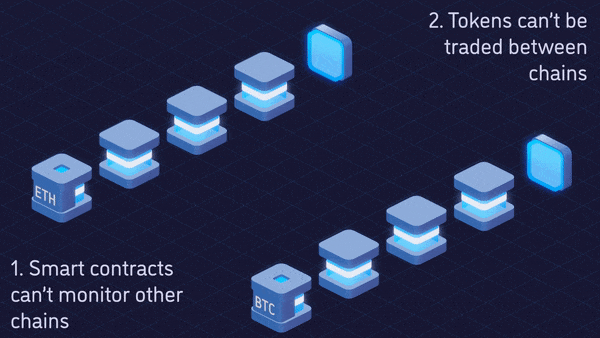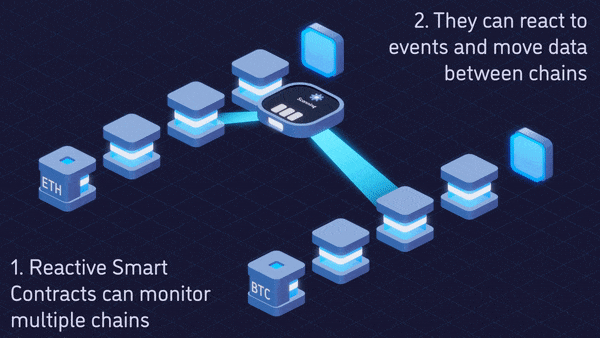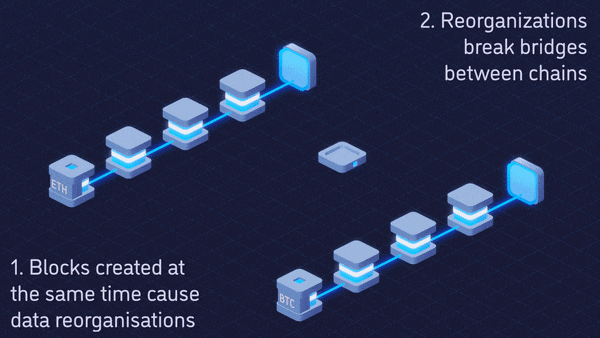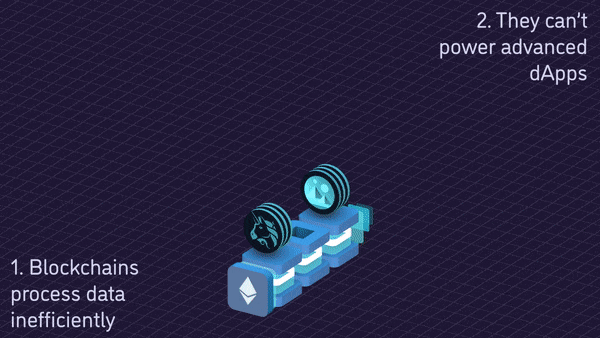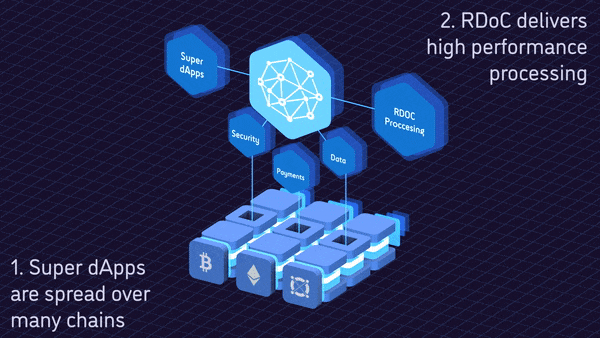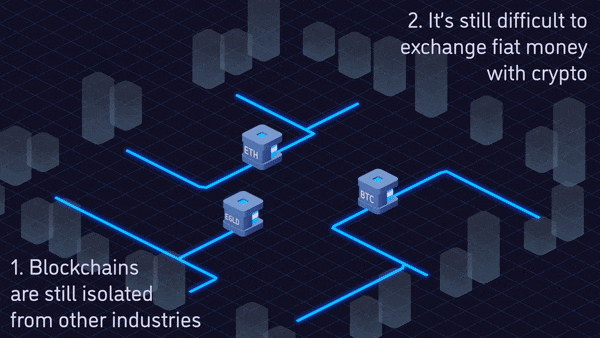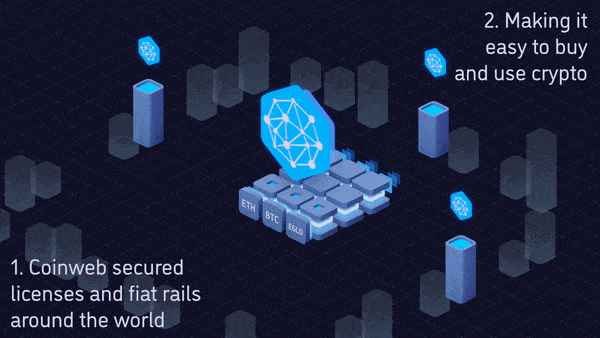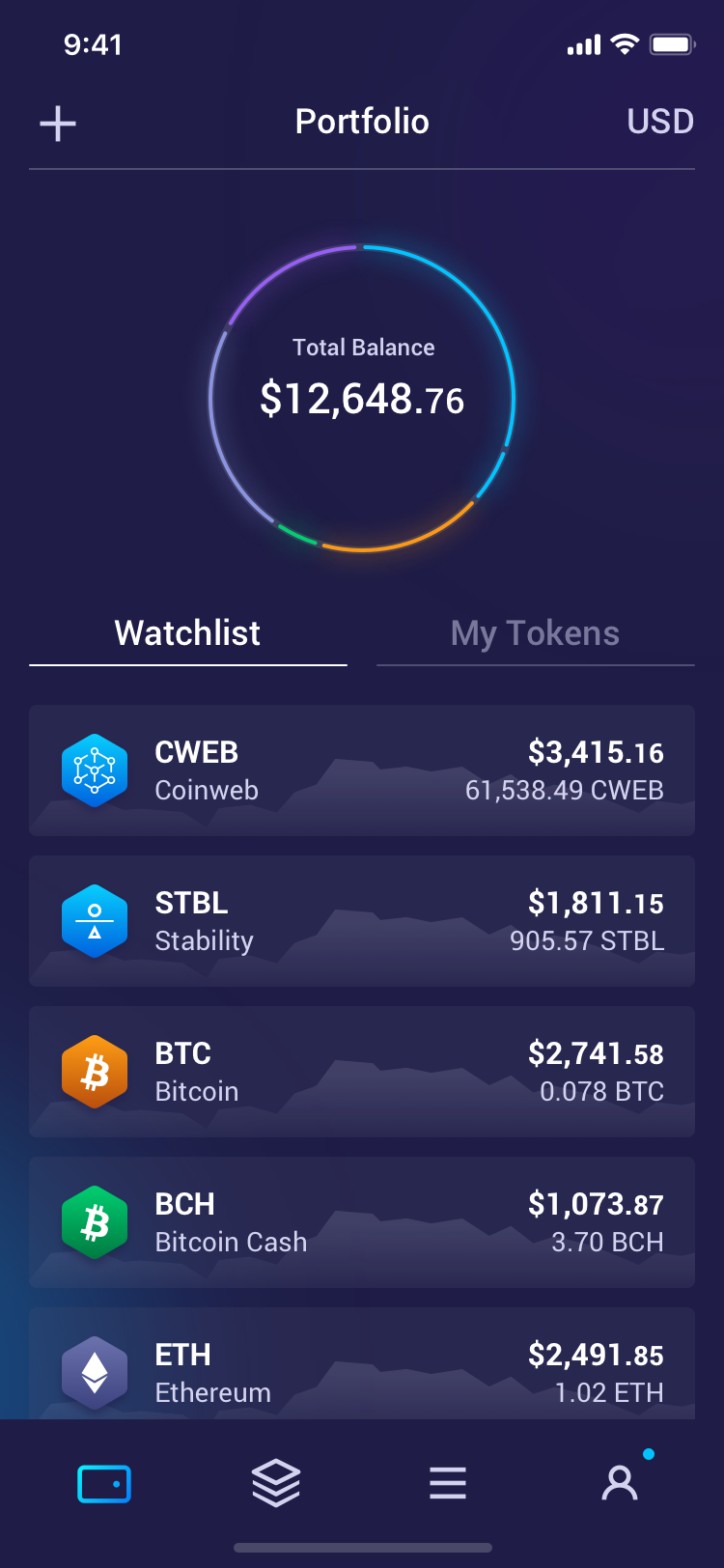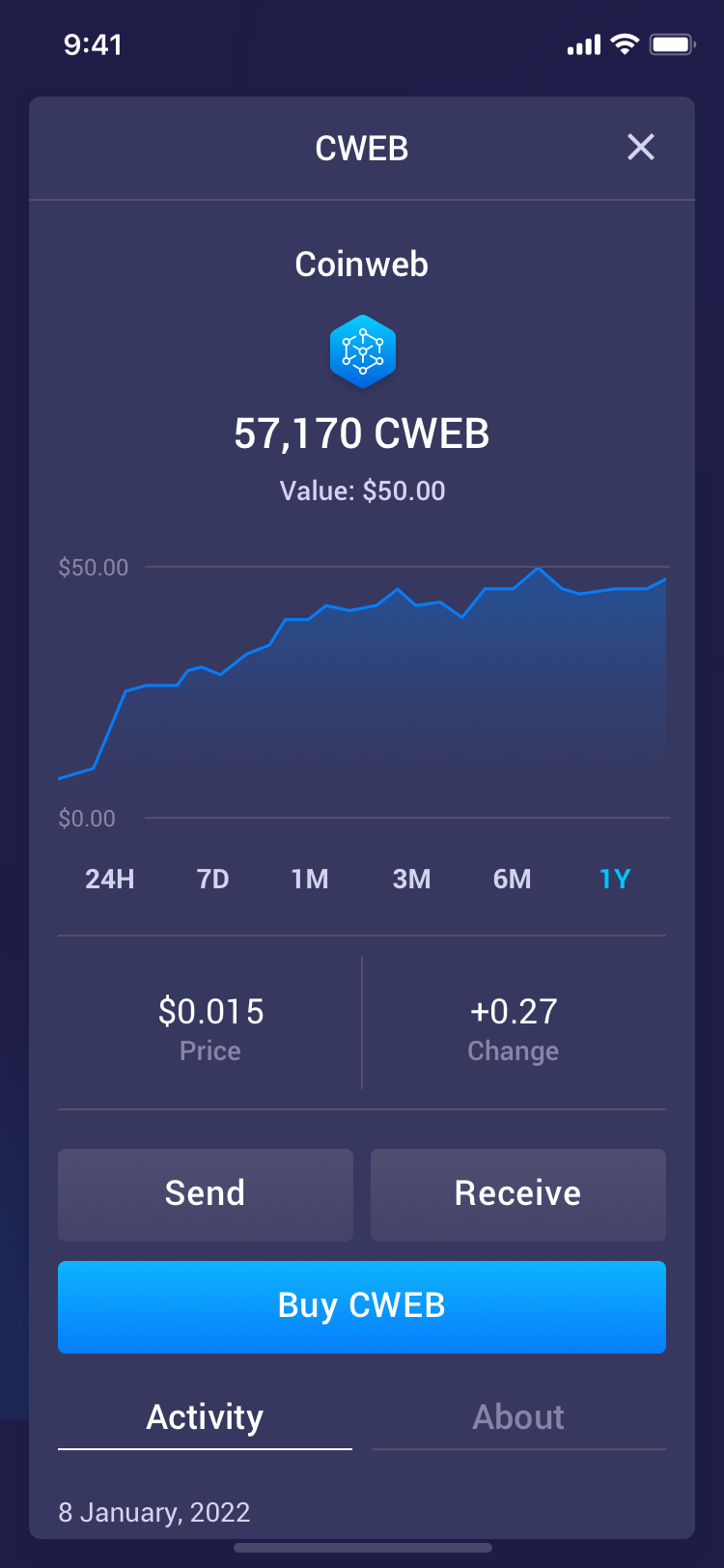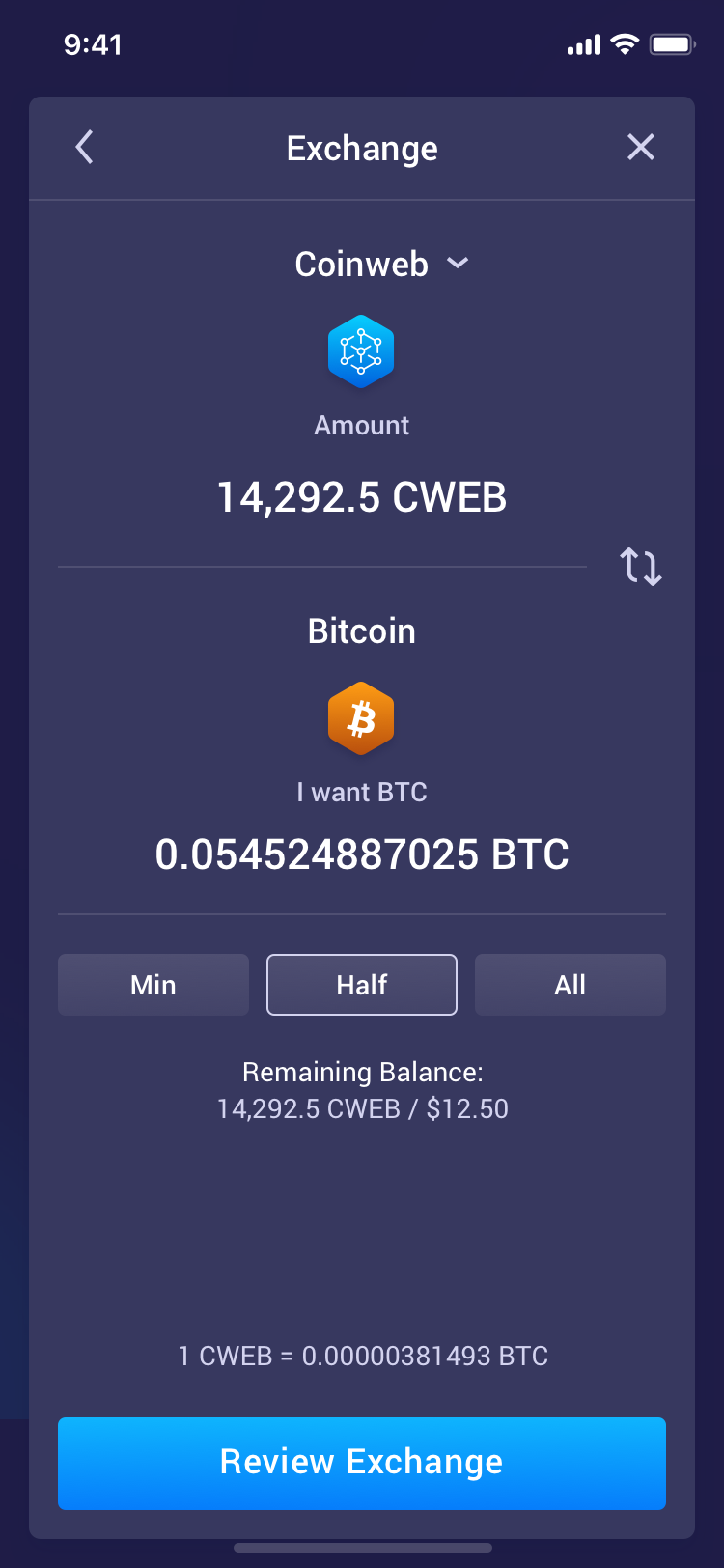
An Introduction
to Coinweb
Table of Contents
“Despite the hype in the market, blockchain technology is still in its infancy. The state of the market can be compared to the same period as web 1.0 found itself around 2000. For real adoption to occur, the technology must become universally useful.
Coinweb's mission is to achieve exactly that.”
Toby Gilbert - CEO
Disclaimer: This litepaper is intended to strengthen our community by communicating Coinweb’s technology and other important information as effectively as possible. To achieve this, we may periodically update its content as we continuously strive to deliver our message.
The Mission
Building the foundation
for a decentralized future
Almost everything in our world is centralized. This incentivizes our brightest people to act selfishly to the detriment of everyone else.
A decentralized system incentivizes those people to use their genius in the right way because it's the majority that rewards them for doing so.
The benefits of such a system are so enormous that they’re only beginning to be realized. The promise of which has the potential to deliver peace, prosperity and equality, to mention just a few. But decentralization is also challenging to achieve.
There's a lot of theory and not enough building of protocol and product to actually deliver this. What you get are people accusing the industry of hype and having little intrinsic value, in many cases a fair accusation.
So, how do we separate the signal from the noise so we can understand decentralization’s potential to tackle the seemingly insurmountable challenges we're facing today and forward our potential horizons?
We are here to deliver and enable that progress. We're not another token hype. We are developing blockchain’s much-needed infrastructure and building the foundation for an incredible decentralized future.
Introduction
The Decentralized Cloud
Coinweb is building a decentralized cloud that anyone can use, is extremely powerful, has no central authority and provides access to Blockchain’s groundbreaking technologies and liquidity.
The decentralized cloud plugs into existing and new blockchains that sit below it, connects to traditional industries around it and allows developers to create powerful decentralized projects on top of it that promise a more advanced, fair and prosperous society for everyone.
Technology
There are four big problems with blockchains today.
Here are some of Coinweb's respective solutions

Problem #1
Blockchain Isolation
Solution
Reactive Smart Contracts
The Problem
Technology
Current blockchains are isolated from one another, preventing people from taking advantage of their full potential.
If we want to sell an Ethereum token for Bitcoin for example, we’d need an Ethereum smart contract that monitors payments on Bitcoin and then transfers our tokens to the buyer on Ethereum.
Current smart contracts can’t do this because they can’t stay active indefinitely. They require an external payment to execute their code and then they go back to sleep to wait for the next payment. This prevents blockchains from communicating with each other.
Technology

Problem #1
Blockchain Isolation
Solution
Reactive Smart Contracts
The Solution
Coinweb’s Reactive Smart Contracts have their own wallets which they can use to pay themselves.
This allows them to stay active continuously to monitor, move, process or synchronize data between blockchains without the need for external payments.
If a buyer pays for Ethereum-based tokens using Bitcoin, a Coinweb Reactive Smart Contract monitors the payment on the Bitcoin chain and automatically transfers the corresponding tokens on Ethereum.
Reactive Smart Contracts can also run in a loop or connect with other Reactive Smart Contracts to form a powerful web of contracts that resemble highly advanced software applications.

Problem #2
Inconsistent Data
Solution
Delay Graph & Information Market
The Problem
Blockchain “reorganizations” present another big challenge when synchronizing information across blockchains.
Blockchains are databases maintained by thousands of nodes competing to organize incoming data into the next block. When two nodes happen to create the next block at the exact same time, two separate chains are maintained until one version becomes more secure. A reorganization happens when a new version of the chain is considered the most secure and therefore some transactions that were included in the old chain are now suddenly not included anymore.
If we just transferred an amount of ETH to a buyer who paid on Bitcoin, a reorganization on Bitcoin could reverse their payment without returning our tokens on Ethereum, resulting in inconsistent data between the two chains.
Reorganizations happen rarely, but they prevent us from reliably synchronizing data across blockchains. If your computer was set up like this, its data would slowly disintegrate.
Technology
Technology

Problem #2
Inconsistent Data
Solution
Delay Graph & Information Market
The Solution
Coinweb's Delay Graph removes the threat of reorganizations by delaying information sent to other blockchains. This allows us to reliably synchronize data across blockchains.
In our previous example, a buyer must wait a while to receive their Ethereum tokens when paying with Bitcoin. If a Bitcoin reorganization happens during this time, the payment doesn’t go through. No error occurs and the buyer resubmits their payment a second time.
In the rare case of a reorganization that’s longer than our delay, Coinweb can reorganize data across all connected chains in the Coinweb layer, but not on underlying chains. This is one of many reasons developers are likely to build through Coinweb instead of underlying chains directly.
Instant, Guaranteed SettlementIf an app requires information from different chains instantly, it can ask for it via information traders who take on the risk of reorganizations in return for a fee. You can read more about the information market
here.
Technology

Problem #3
Limited Scale
Solution
Inchain Architecture
The Problem
Ethereum’s smart contracts are simple software applications that enabled the first decentralized applications (dApps) like Uniswap.
But, running these applications on blockchains is extremely inefficient because they require every single node to process every single transaction (nodes are often personal computers that maintain a blockchain network). Ethereum has over 300,000 nodes that have to process every single transaction, making the network slow and expensive.
This makes it impossible to run more advanced decentralized applications that could compete with Netflix or Instagram, which require a million times more processing than even the most advanced dApps in use today.
Technology

Problem #3
Limited Scale
Solution
Inchain Architecture
The Solution
Coinweb’s Inchain Architecture allows developers to shard (break up) different components of an application and spread them optimally over different blockchains and the decentralized Coinweb processing layer.
It securely stores raw data in various underlying blockchains and processes data in Coinweb’s decentralized computational layer using the highly efficient “refereed delegation of computation” protocol (RDoC). You can read more about the RDoC protocol
here.
This allows developers to run much more advanced decentralized applications than anything possible today.
Technology

Problem #4
Industrial Isolation
The Problem
Crypto is still isolated from other industries because it’s difficult to exchange fiat money with cryptocurrencies on nearly every platform. This is due to a very complex and evolving global regulatory environment.
To obtain licenses from different jurisdictions, a project must go through stringent application processes including KYC/AML, auditing, legal consultation, enterprise risk assessment and provision of a detailed and regularly updated business plan.
This usually requires a local entity, offices, employees and hundreds of thousands of dollars invested per jurisdiction.
As a result, crypto and blockchain technology is rarely used in other industries despite their massive potential benefits.

Problem #4
Industrial Isolation
The Solution
Coinweb has made significant investments to secure its own licenses and fiat rails, making it easy to exchange the most common fiat currencies with CWEB around the world.
Projects building on top of Coinweb can simply use our licenses and fiat rails without incurring the costs of obtaining their own, enabling much deeper penetration into traditional business sectors.
As a result, applications built on top of Coinweb can deliver the massive benefits of blockchain technology and our superior processing power to almost every part of the global economy.
Coinweb’s Solutions
Technology
The implications of the decentralized cloud for the
global economy are staggering.
Unlike blockchains which compete against each other, Coinweb’s decentralized cloud is symbiotic to the entire industry. Users and developers can continue using their existing tokens and smart contracts and enhance them in the cloud.
This symbiotic nature allows anyone to start using the most advanced blockchain technologies, run powerful dApps, raise funds, manage organizations, grow communities and decentralize nearly every aspect of their lives. This underscores Coinweb’s near limitless potential to provide utility and value to any person, business, or organization, and paves the way for future mass adoption.
Consumers can benefit from the growth of this decentralized economy through the Coinweb token and manage their funds across multiple crypto and fiat currencies.
Products & Features
Delivering the benefits
of decentralization
Coinweb’s rapidly growing team of over 140 staff, including 50 in-house developers, and various partner projects are committed to delivering decentralized products that impact our lives, today. The following are some of the most exciting applications we’re developing in the near and medium-term.
Products & Features
The Decentralized Cloud
Decentralized applications called dApps are still mostly limited to decentralized finance use cases due to scaling limitations. Centralized apps like Facebook and Google are increasingly distrusted by consumers.
The Cloud allows developers to eventually build powerful decentralized apps that can compete with Instagram or Gmail and it allows centralized apps to easily access blockchain features such as decentralized IDs, data verification, crypto payments and more...
Here are some of the unique advantages developers can gain by connecting to the Cloud:
1. Cross-Chain dApps
Terra’s recent collapse and Ethereum’s high gas fees are two important examples of why developers can’t depend on single chains to run their dApps. The Cloud’s cross-chain routing system constantly monitors the performance of underlying chains, allowing developers to seamlessly move their applications from one chain to another should one become too expensive, slow, or have a catastrophic failure. This delivers continuity of service and stability to the end-user.
Developers can also spread their applications over the most suitable chains. For example, a decentralized news service can store news articles on Solana, let users vote on article quality on Polkadot, verify user accounts through Ethereum and receive payments on various other chains.
Products & Features
2. Powerful Processing
Most blockchain consensus mechanisms require every node in a network to process every computation, which is extremely inefficient. The Cloud verifies a dApp’s relatively small amount of unprocessed data in underlying blockchains, but it verifies processed data (which is usually exponentially greater than its unprocessed data) using deterministic computation protocol (RDoC). This requires only a few hundred nodes to provide the same level of security for computations as the underlying consensus mechanism.
The Cloud will be able to support advanced dApps similar to centralized apps like Facebook and Gmail. However, bandwidth and storage-intensive applications such as video calling and collaborative image editing will likely take longer due to storage limitations of current blockchain technology. However, developments in this field have traditionally progressed exponentially, so we believe we’ll be able to run decentralized versions of even the most complex applications on top of Coinweb sooner than most people think.
3. Unified Development
Many web developers can’t develop dApps because it requires them to learn new blockchain-specific programming languages like Solidity. The Cloud allows coders to develop their apps using popular programming languages, like JavaScript, Python, or Rust and it compiles these codes to WebAssembly (WASM), which is already being used in WASM-compatible programs such as Google Chrome and many more. This unifies the developer space. It allows thousands of experienced coders to start developing decentralized applications and it makes these dApps much more compatible with the browsers, phones and applications we use in our daily lives.
Products & Features
4. Automatic updates, maintenance and scaling
Maintaining regular apps is slow and difficult. It’s like assembling puzzles from random pieces that don’t fit. Selecting the most suitable language, database, and security, as well as keeping everything updated and compatible is a constant struggle.
Blockchains run on economically incentivized nodes. This means everything runs and updates automatically. Coinweb also lets you switch between chains whenever you like. For example, when a chain gets cheaper, offers better features, or grows a bigger community; or, when your dApps’ specific needs have evolved over time to require a more optimal solution.
This means that coders never have to worry about maintaining their dApps again. They simply code it, deploy it, and the rest just works!
Products & Features
The Gateway to Crypto
Coinweb’s Gateway to Crypto makes it easy for anyone to use our cross-chain features through a growing suite of products. It will be the first consumer-ready cross-chain Layer-2 token creation platform, enabling the first blockchain agnostic tokens and NFTs that can be used in a decentralized and interconnected marketplace. This includes issuing, moving and selling tokens across chains, secure bridging, broad marketplace integrations upon mainnet launch and more.
The first 3 products are scheduled to launch by the end of 2022 and provide services for personal and professional use.
1. Coinweb Wallet
The Coinweb Wallet allows anyone to create tokens and send, receive and trade them with others. This will be a no-code application that requires no experience and is an easy way to start adopting crypto into your daily life. You can create reward tokens for family members or employees by selecting from a choice of pre-designed tokens and start using them right away. More experienced users can buy tokens on the marketplace and exchange them with fiat currencies to manage their assets across the ecosystem.
Products & Features
2. Cross-Chain Tokenization Platform
Tokenization platforms are used to turn regular assets into tokens, including financial assets, commodities, art, intellectual property, real estate and much more. This allows you to better manage or trade assets and to use blockchain technology for employee motivation, decision making, payment management and getting access to vast liquidity pools.
For example, an apartment building could provide owners with tokens to help make group decisions and transfer an owner’s rights when a property is sold. A company could decide to tokenize their entire operation to easily keep track of their assets, motivate employees, make decisions, and the list goes on.
Creating organizations on one blockchain is risky because it could fail, also impacting any organization built on top of it. Or, an entirely new blockchain might come along with much better features suited to their particular use case.
Through Coinweb’s CCTP, businesses can create blockchain agnostic tokens that can move across chains without requiring any coding knowledge. Its user-friendly website lets you choose from a set of pre-designed tokens, smart contracts and NFTs and adjust each setting as needed. Once created, these assets are embedded into a chain of your choice and can be moved to another chain at will. They can be traded on Coinweb’s simple marketplace and eventually, you’ll be able to bridge them down to any chains that are connected to the Coinweb Cloud, allowing your tokens to connect with nearly all major exchanges and dApps in the industry.
Products & Features
3. Multi-Tenancy Wallets
Organizations can partner with Coinweb to create their own branded Wallet with custom designs and functionalities, allowing their communities to create tokens within their own ecosystems.
For example, an air alliance could create their own Wallet, allowing each member airline to create its own loyalty tokens through them. A multinational car manufacturer could unify their entire operation through their own Wallet with different departments, suppliers and customers creating, using and trading tokens and NFTs for various purposes.
Tokens and NFTs can be used to streamline payments, decentralize governance, issue corporate bonds and manage loyalty programs - and everything is tradable on the Coinweb marketplace. Multi-Tenancy Wallets come with full operational support including web development, customer services, anti-fraud protection, accounting and other operations.
Coinweb’s regulatory umbrella supports crypto operations across North America, Europe and Asia-Pacific. It also includes integrated fiat rails with credit card processing, SWIFT, SEPA, Faster Payments and localized account-to-account transfers as well as pre-paid crypto debit-card issuance.
Products & Features
We’re not stopping here...
The products we’re launching
in the mid-term include:
Parallel execution
of smart contracts
Cross-chain
liquidity pools
Cross-chain
smart contracts
Cross-chain erasure-
coded transactions
The future of blockchain is about collaboration. That’s why Coinweb is partnering with industry leaders to develop robust technologies and reliable user experiences. Contact us if you’d like to explore integrating our technology with yours!
The CWEB Token
CWEB
A lot of today’s blockchain infrastructure is centralized. This includes exchanges, to which you have to give up control over your tokens and sensitive personal information. Decentralized exchanges like UniSwap are the future of DeFi because they are fully decentralized. But, they are fixed to a single chain.
For example, you can’t trade a token from the Polkadot ecosystem on an Ethereum-based exchange. Tokens that are fixed to a single chain also risk losing their value if their underlying chain fails (as it happened with Terra).
CWEB is the world’s first blockchain agnostic token, embedded into multiple underlying chains via the Coinweb protocol. It can move freely between all connected chains, allowing it to be traded on various decentralized exchanges and move to a different chain if a chain is failing, has security breaches or becomes too expensive.
CWEB was launched as an ERC20 token and will be converted to the native Coinweb token on Layer 2 before mainnet release, where it will be used by various economic actors.

The CWEB Token
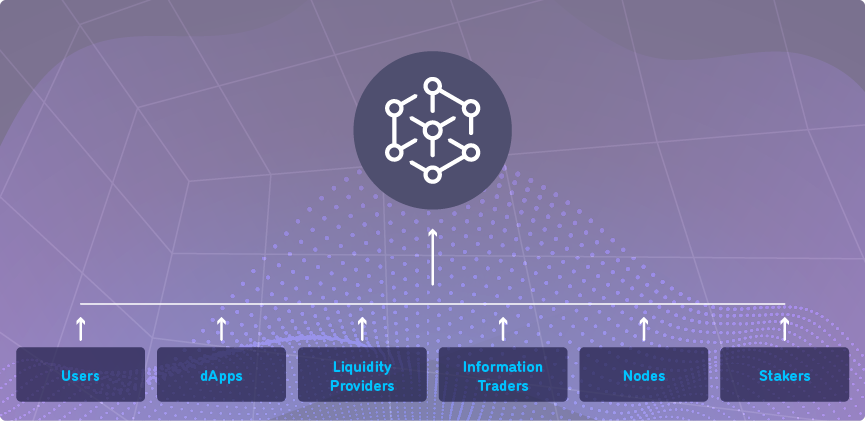
Coinweb’s economic actors include:
Users
People who use dApps and manage their crypto and fiat assets on top of Coinweb.
dApps
Applications built on top of Coinweb that provide services to users.
Nodes
Independent actors who provide decentra-lized computations and verification
Liquidity Providers
Users who provide liquidity for various processes in the Coinweb economy.
Stakers
Users who provide security for various processes in the Coinweb economy.
Information Traders
Independent actors that synchronize the Coinweb layer with underlying chains.
The CWEB Token
Pre-Mainnet Staking
Pre-mainnet staking supports the project by providing stability and encouraging more participation. In return, stakers are rewarded with a predetermined and dynamic rate of tokens proportionate to the amount that is staked over time. The pre-mainnet staking program is already live, so please watch the videos to learn more about the program and how you can participate.
Our Team
Toby attended UCL and went on to focus on the tech and telco spaces. With a proven track record of founding new start-ups, including having successfully invested in and exited three telecommunications companies operating in Europe, Africa and Asia, Toby invested in and led the OnRamp team as well as co-founding and leading the Coinweb project since 2018.
A tech pioneer and early adopter of digital currencies and payment systems, Knut attended University of Oslo. His thesis on evolutionary hardware was published by NASA and the US Department of Defense. Knut developed one of the first online mobile slot machines and has worked extensively in telecommunications as CTO of Nouvel Air Group Inc. Knut is also a founder and an architect of the OnRamp platform.
Andrew is a chartered accountant with a Master of Applied Finance from Macquarie University, Sydney. Since leaving university, he has held a number of senior accounting and CFO roles with the likes of Automotive Holdings Group, Telstra and Lloyds International. He has been investing and maintaining a keen interest in crypto projects (specifically tokenomics) since 2016.
Our Team

Alexander Kjeldaas
Lead Architect
Alexander is an experienced technical architect with a particular focus on Artificial Intelligence, blockchain, and security. A graduate of the Norwegian University of Science and Technology with an MSc in Computer Sciences, he had a seven-year tenure holding senior positions at Google and FAST. Alexander is also the founder of astor.ai and Formal Privacy, developing a system for secure cloud computing using blockchain security proofs, and is the founder of Guardian Networks. Furthermore, Alexander has contributed to the Bitcoin blockchain in the area of thread safety and was the first developer to implement cryptography APIs in the Linux kernel.

Jurgen Thoelen
Operations Director
Having held positions such as Vice President at Siemens Telecommunications based in Munich and Head of Business Development for Nokia, North and East Europe, Russia, Turkey and Central Asia, Jurgen has always been focused on the emergence of blockchain-based technology. Jurgen joined OnRamp in 2020, driving its launch as Operations Director.

Valentin Lundgren
Design Director
Valentin has a Bachelor of Industrial Design from Istituto Europeo di Design, Milan and more than 15 years of experience in visual arts, graphic design and web design. He is a former designer for the strategic design agency POND in Stockholm, where he developed brands for spirits, tobacco, and gambling companies such as Pernod Ricard, Swedish Match, and Svenska Spel. For the past six years, he has been Art Director for Portfoliobox, with a focus on UI and UX Design. Over a million websites have been created by the creative community with his designs.





